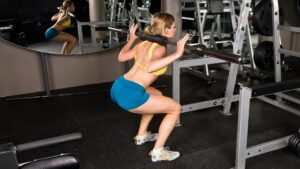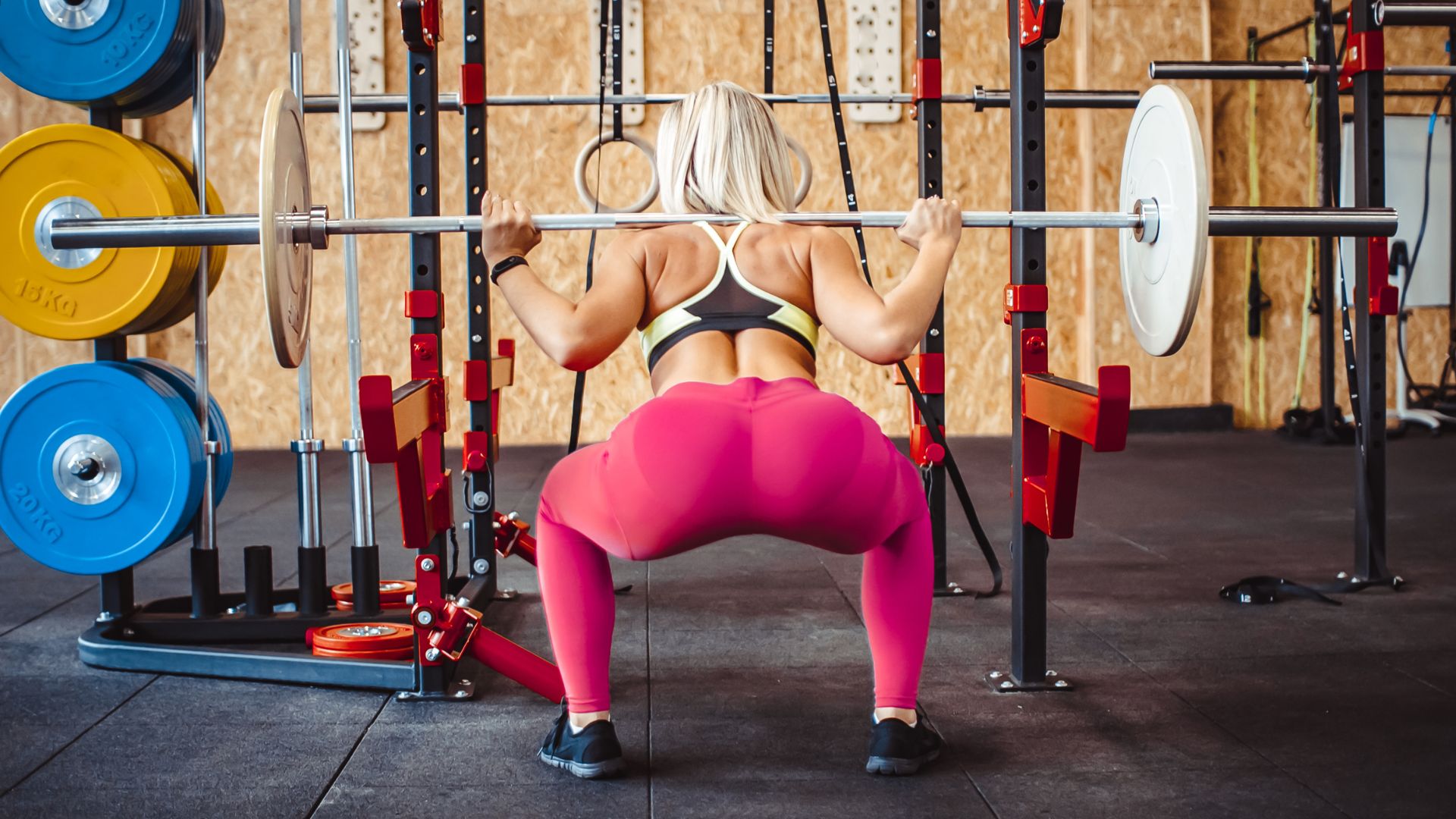Hey there, fitness enthusiasts! Ever wondered about the impact of those 20 consecutive squats with a barbell on your glutes? We’re diving into the nitty-gritty of this popular exercise in our latest blog post.
Whether you’re a seasoned lifter or just starting out, join us as we explore how to get the most out of those squats while keeping your glutes in top shape. Let’s get started!
Understanding whether or not doing 20 squats in a row with a barbell is bad for the glutes.
Yes, if not done correctly, and No, if done the right way. Doing 20 squats in a row with a barbell can be a beneficial exercise for your glutes and overall lower body strength, but it’s important to perform them with proper form and technique with focus to minimize the risk of injury.
Here are some considerations:
Form and Technique: Using proper form and technique is crucial when performing squats with a barbell.
Ensure that your back is straight, your core is engaged, and your knees are aligned with your toes.
Descend by pushing your hips back and bending your knees, keeping the weight over your midfoot.
Warm-Up: Always warm up your muscles before performing any heavy lifting exercises.
This helps increase blood flow to the muscles, making them more pliable and reducing the risk of injury.
Progressive Overload: If you’re new to squats or haven’t done them with a barbell before, it’s important to start with a weight that you can comfortably manage and gradually increase it as you become more experienced and stronger.
Don’t start with a weight that’s too heavy for you to control.
Range of Motion: Ensure that you’re going through the full range of motion in your squats.
Going deep enough in your squat will engage your glutes more effectively.
However, avoid going too deep if it causes discomfort or places excessive strain on your knees.

Rest and Recovery: Allow your muscles to recover between sets.
Overdoing it without proper rest can lead to muscle fatigue and increase the risk of injury.
Consult a Trainer: If you’re unsure about your form or technique, consider working with a certified personal trainer who can provide guidance and correct any errors in your squatting form.
In summary, doing 20 squats in a row with a barbell can be a beneficial exercise for your glutes and lower body strength if performed correctly.
It’s essential to prioritize proper form, warm-up, gradually increase the weight, and ensure adequate rest and recovery to minimize the risk of injury and maximize the benefits for your glutes and overall fitness.
Further Explanations.
Let’s dive deeper and elaborate further on all the points mentioned.
First, let’s dive into more detail about the importance of proper form and technique as well as the significance of warming up when performing squats with a barbell:
1. Form and Technique.
Back Alignment:
Maintaining a straight back during squats is essential to protect your spine. Imagine a straight line running from your head to your tailbone.
Avoid excessive rounding or arching of the back, which can lead to injury.
Core Engagement:
Your core muscles, including your abdominal muscles and lower back, play a crucial role in stabilizing your spine during squats.
Engaging your core means contracting these muscles to create a strong, stable midsection.
Knee Alignment:
Ensure that your knees are in line with your toes throughout the squat movement.
They should not collapse inward or push too far forward beyond your toes, as this can stress your knee joints.
Hip Movement:
The squat motion involves pushing your hips back and bending your knees simultaneously.
This movement pattern engages your glutes and hamstrings effectively while also protecting your knees.
Weight Distribution:
Keep the weight over the midfoot, not on your toes or heels.
This helps you maintain balance and stability throughout the squat.

Depth of Squat:
Descend to a depth that is comfortable for you while maintaining good form.
Ideally, your thighs should be at least parallel to the ground, but you can go deeper if you have the flexibility and mobility to do so without compromising form.
2. Warm-Up.
Warming up before performing squats or any heavy lifting exercises is essential for several reasons:
Increased Blood Flow:
When you warm up, your heart rate increases, and more blood is pumped to your muscles.
This increased blood flow delivers oxygen and nutrients to the muscles, making them more pliable and ready for exercise.
Improved Muscle Elasticity:
Warming up helps increase the elasticity of your muscles, making them less prone to strains and tears during exercise.
Joint Lubrication:
Warming up also lubricates your joints, reducing friction and improving their range of motion.
A simple warm-up routine for squats might include light aerobic exercises (like jogging or jumping jacks) to increase your heart rate, followed by dynamic stretches that focus on the muscles you’ll be using (such as leg swings or hip circles).
Additionally, doing a few sets of bodyweight squats with proper form can help prepare your body for the heavier loads of barbell squats.
By paying attention to form and warming up properly, you can reduce the risk of injury and optimize the effectiveness of your squatting routine.
let’s explore the importance of progressive overload and proper range of motion when performing squats with a barbell:
3. Progressive Overload:
Gradual Progression:
Progressive overload is a fundamental principle of strength training. It means gradually increasing the resistance or weight you lift over time to stimulate muscle growth and strength gains.
When you’re new to squats or using a barbell, it’s crucial to start with a weight that allows you to perform the exercise with good form and control.
Avoiding Excessive Weight:
Starting with a weight that’s too heavy can lead to poor form and an increased risk of injury.
It’s important to find a weight that challenges you but still allows you to maintain proper technique. You should be able to complete your desired number of repetitions with control.
Incremental Increases:
As you become more experienced and stronger, you can gradually increase the weight you lift.
This progression can be achieved by adding small increments of weight to the barbell, such as 5 or 10 pounds, and ensuring that you can maintain proper form as you do so.
4. Range of Motion.
Full Range of Motion:
Going through the full range of motion in your squats is essential for maximizing the engagement of your muscles, including the glutes.
This means descending to a depth where your thighs are at least parallel to the ground.
A full range of motion ensures that you’re activating a broader range of muscle fibers and can lead to more significant strength and muscle gains.
Glute Engagement:
When you squat deep enough, your glutes are engaged to a greater extent.
This is because the glutes are responsible for hip extension, which is a key component of the squat movement.
Ensuring proper depth in your squats helps target and strengthen the glute muscles effectively.
Comfort and Safety:
While it’s important to aim for full range of motion, it’s equally important to do so comfortably and without pain.
Some individuals may have mobility limitations or discomfort when squatting too deep.
In such cases, it’s acceptable to squat to a depth that is comfortable and safe for you while still challenging your muscles.
Avoiding Knee Strain:
Going too deep in your squat can sometimes place excessive strain on the knees, especially if your form is compromised.
It’s essential to find a depth that allows you to maintain proper alignment of your knees and protect the joint.
In all this, progressive overload involves gradually increasing the weight you lift in squats over time to promote strength gains, while proper range of motion entails squatting to a depth that engages your glutes effectively while considering your comfort and safety.
Balancing these factors will help you achieve the best results and minimize the risk of injury during barbell squats.
let’s delve into the importance of rest and recovery, as well as the benefits of consulting a certified personal trainer when performing squats with a barbell:
5. Rest and Recovery.
Muscle Recovery:
Allowing your muscles to recover between sets is essential for several reasons. During resistance training exercises like squats, your muscles experience microtears, and rest is when they repair and grow stronger.
Without sufficient rest, these microtears may accumulate, leading to muscle fatigue and potentially increasing the risk of injury.
Proper Breathing:
Rest periods also provide an opportunity to catch your breath and maintain proper breathing technique.
Proper breathing during squats helps stabilize your core and maintain form.
Preventing Overtraining:
Overtraining, which occurs when you don’t allow adequate rest between workouts, can lead to decreased performance, increased risk of injury, and burnout.
Proper rest ensures you’re training effectively and safely.
Set and Repetition Performance:
Rest intervals between sets can vary depending on your goals. For strength training with heavier weights, longer rest periods (2-5 minutes) may be needed to allow for maximal recovery between sets. For hypertrophy (muscle-building) training, shorter rest periods (30 seconds to 1.5 minutes) can be used to maintain intensity.
6. Consult a Trainer.
Expert Guidance:
Consulting a certified personal trainer, especially if you’re new to squats or have concerns about your form, can be incredibly beneficial.
Trainers are experts in exercise technique and can provide personalized guidance based on your specific needs and goals.
Form Correction:
A trainer can assess your squat form and make real-time corrections to ensure you’re performing the exercise correctly and safely.
This can help prevent injury and maximize the effectiveness of the exercise.
Program Design:
Trainers can also help design a workout program tailored to your goals, whether it’s building strength, increasing muscle size, or improving overall fitness.
They can provide variety and progression in your squatting routine to keep it challenging and engaging.
Motivation and Accountability:
Having a trainer can also provide motivation and accountability. Knowing that you have a scheduled session with a trainer can help you stay consistent with your workouts.
In summary, allowing adequate rest and recovery between sets during squats is crucial for muscle repair and overall safety.
Consulting a certified personal trainer can provide you with expert guidance, form correction, and a customized workout plan to ensure you’re getting the most out of your barbell squats while minimizing the risk of injury.
A concise tabular on this topic here.
Here’s a concise tabular summary of the topic “Doing 20 Squats in a Row with a Barbell and its Impact on the Glutes”:
| Aspect | Impact on Glutes |
|---|---|
| Form and Technique | Proper form engages glutes effectively and safely. |
| Warm-Up | Proper warm-up enhances glute muscle readiness. |
| Progressive Overload | Gradual progression with the right weight builds glutes. |
| Range of Motion | Full range of motion targets and strengthens glutes. |
| Rest and Recovery | Adequate rest prevents glute fatigue and overtraining. |
| Consult a Trainer | Trainer guidance ensures correct form for glute activation. |
Remember, when done correctly and with attention to these aspects, performing 20 squats in a row with a barbell can be an effective way to engage and strengthen the glutes while minimizing the risk of injury.
Conclusion.
In conclusion, performing 20 squats in a row with a barbell can be beneficial for the glutes and overall lower body strength when done with proper form, gradual progression, and attention to range of motion.
Adequate warm-up, rest, and the option to consult a trainer are key factors that contribute to a safe and effective squatting routine.

Hey there, it’s Mike Rrsq, the Editor-in-Chief over at Jsquat.com, and I’m absolutely obsessed with all things squat fitness! I’ve been lucky enough to get some serious recognition for my work in this field. With a solid background in the fitness and wellness industry, I’ve been there right from the get-go, helping shape this website into what it is today.
You see, I’m not just the boss around here; I’m also a passionate contributor. I love sharing my insights through my articles, and trust me, they’re not your run-of-the-mill stuff. Each piece I write is a labor of love, filled with my expertise and real-world experience in the fitness universe. So, if you’re into fitness and looking for some inspiration, you’re in the right place!

